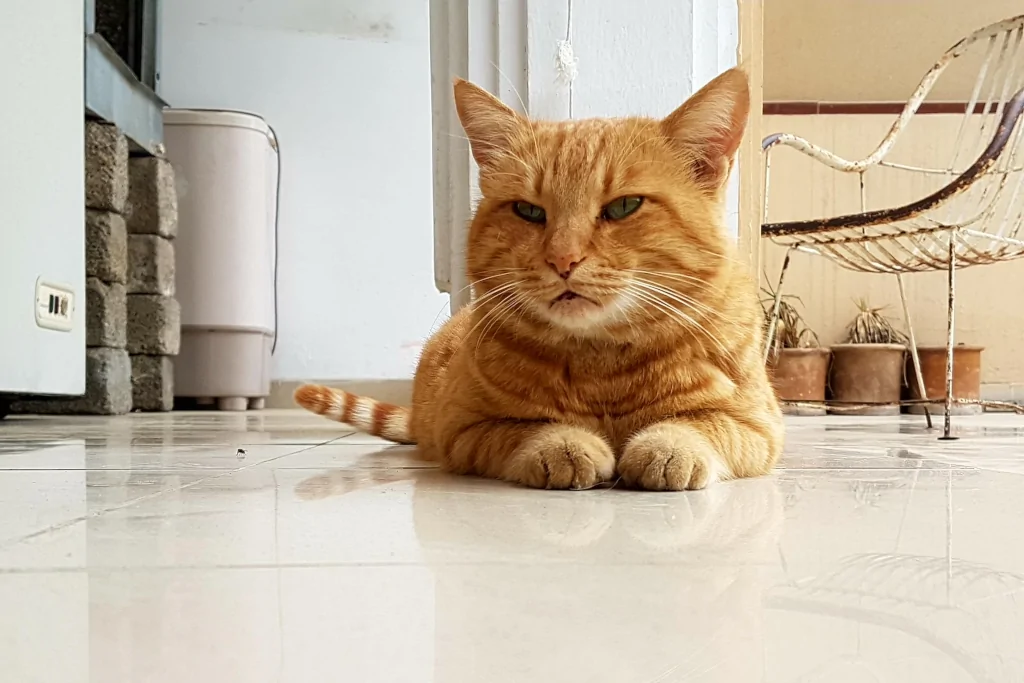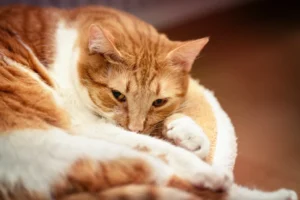Disclosure: We may earn a commission from helpful, relevant links in our content. No cost to you. See our privacy policy.
Your cat has probably been acting a little off lately, and now you’re scouring the internet for answers, worried it might be something serious.
As a fellow cat parent, I understand that sinking feeling, unsure of what could be affecting my precious furball.
One possible culprit you may come across is lungworms, an often-overlooked parasite that can wreak havoc on your cat’s respiratory system.
I remember when my neighbor’s cat started coughing and wheezing, and after a quick trip to the vet, they discovered it was a lungworm infection. The relief of finally knowing what was wrong and being able to tackle the issue was immense.
In this article, we’ll explore lungworms in detail, from identifying the signs of infection to effective treatment and prevention strategies. Together, we’ll ensure your cat stays happy, healthy, and lungworm-free.

What Are Lungworms and How Do Cats Become Infected?
Lungworms are parasitic worms that can infect your cat’s respiratory system, particularly the lungs and surrounding blood vessels.
Two common species of lungworms that affect cats are Aelurostrongylus abstrusus and Capillaria aerophila.
Cats typically become infected by ingesting the larvae of these parasites, which can be found in intermediate hosts like snails, slugs, or even small rodents. Your feline friend may accidentally consume these hosts while grooming, hunting, or playing outdoors.
What Are the Potential Health Risks Associated With Lungworms?
While some cats may show no symptoms, lungworm infection can lead to a range of health issues.
Mild cases can result in coughing, wheezing, and difficulty breathing. In more severe cases, lungworms can cause significant damage to your cat’s respiratory system, potentially leading to pneumonia, bronchitis, or even respiratory failure.
Early detection and treatment are key to minimizing the risks and ensuring your cat’s well-being.
How to Recognize the Signs of Lungworm Infection in Your Cat?
Respiratory Symptoms
One of the most common signs of lungworm infection in cats is respiratory distress. Pay attention to any coughing, wheezing, or labored breathing your cat may be experiencing.
Observe your cat’s breathing when they’re at rest. A respiratory rate that’s consistently above 40 breaths per minute when relaxed could hint at an underlying issue.
These symptoms can be subtle, so keep an ear out for any unusual noises or changes in your cat’s breathing pattern.
Lethargy and Loss of Appetite
Cats with lungworm infection may exhibit general signs of illness, such as lethargy and loss of appetite. If you notice your cat is less active than usual or showing a decreased interest in food, it’s important to consult your veterinarian for a thorough evaluation.
Weight Loss and Poor Body Condition
In more advanced cases of lungworm infection, cats may suffer from significant weight loss and poor body condition. If your cat starts to look thin or unwell, it’s essential to seek veterinary care as soon as possible.
Changes in Behavior
I remember once my cat started acting unusually aggressive and irritable. This was a red flag for me since she was typically a very affectionate and easygoing cat. Playful all the time.
Upon taking her to the vet, we discovered she had a lungworm infection that was causing her discomfort and affecting her behavior. This experience taught me that changes in behavior can be an essential clue in detecting underlying health issues, such as lungworms.
By keeping a close eye on your cat’s overall health and behavior, you can detect the signs of a potential lungworm infection early and seek appropriate treatment to ensure your feline friend’s well-being.

How to Treat Your Cat for Lungworms
When it comes to treating your cat for lungworms, it’s important to take a comprehensive approach. This involves using prescription medications, providing supportive care during treatment, and preventing re-infection. Let’s explore these methods in more detail
Prescription Medications
The primary method of treating lungworms in cats is through prescription medications prescribed by your veterinarian.
Some typical prescription medications for treating lungworms in cats include
- fenbendazole,
- moxidectin, and
- ivermectin.
These medications are typically oral or topical anthelmintics, specifically designed to eliminate the lungworms without harming your cat. Your veterinarian will determine the most appropriate medication based on your cat’s specific condition.
It’s crucial to follow your vet’s instructions for administering the medication to ensure its effectiveness.
Supportive Care During Treatment
While your cat is undergoing lungworm treatment, it’s essential to provide supportive care to help them recover more comfortably.
Ensure your cat has a clean, warm, and quiet environment to rest in, and monitor their food and water intake. If your cat is experiencing respiratory issues, your vet may also recommend using a humidifier to help ease their breathing.
I remember when my cat was going through lungworm treatment a long time ago, I made sure to keep her comfortable and stress-free. I set up a cozy area for her with her favorite blanket and some soft toys, which seemed to help her feel more at ease. It’s these small acts of care that can make a difference during your cat’s recovery process.
Monitoring Your Cat’s Outdoor Activities to Minimize Exposure
To reduce the risk of your cat contracting lungworms, it’s crucial to keep an eye on their outdoor activities. If possible, supervise your cat when they’re outside, ensuring they don’t hunt or consume potential lungworm carriers, such as snails and slugs.
You might also consider creating a safe outdoor enclosure or “catio” for your cat to enjoy the fresh air without the risks associated with free-roaming. This can divert their attention from chasing small critters and help reduce their risk of ingesting larvae.
Whether your cat spends time outside or not, it’s crucial to vaccinate them. More so, if the cat has an indoor/outdoor lifestyle, where additional vaccines may apply.
How Can You Prevent Lungworm Infection in Your Cat?
Preventing lungworm infection in your cat starts with awareness and proactive measures. Here are some steps you can take to keep your cat safe from lungworms:
- Regular vet check-ups. Schedule routine veterinary appointments for your cat, which will allow your vet to monitor their overall health and detect any potential infections early.
- Parasite prevention. Speak with your veterinarian about appropriate parasite prevention treatments, such as monthly oral or topical medications, to protect your cat from lungworms and other parasites. Preventative medications include monthly treatments such as:
- selamectin,
- moxidectin, or
- milbemycin oxime,
which can protect your cat against lungworms and other parasites.
- Maintain a clean environment. Keep your cat’s living space and outdoor areas clean, removing potential lungworm carriers like snails and slugs promptly. By regularly cleaning your cat’s food and water bowls, litter box, and bedding, you can minimize the risk of parasites in their environment.
- Educate yourself. Stay informed about lungworms and other common parasites, so you’re well-equipped to recognize the signs and act quickly if your cat shows symptoms.
By taking these preventive measures, you’ll be better prepared to protect your cat from lungworm infections and ensure their ongoing health and well-being. To learn more about other types of worms in cats, check out our ‘heartworms’ guide or the helpful ‘worms in cats’ guide.
Here’s a bit about lungworms from Dr. Karen Becker, co-author of the highly recommended book “The Forever Dog“:
FAQs
Can lungworms be fatal for cats?
Lungworms can be fatal for cats if left untreated, as they can cause severe respiratory distress, damage to the lungs, and other complications.
How do cats become infected with lungworms?
Cats become infected with lungworms through ingestion of intermediate hosts like snails and slugs or through consumption of infected prey animals such as rodents or birds.
Are there natural remedies for treating lungworms in cats?
While some natural remedies may claim to treat lungworms in cats, it’s crucial to consult your veterinarian for an appropriate treatment plan, as these remedies may not be effective or safe for your cat.
Can lungworms be transmitted between cats?
Lungworms are not directly transmitted between cats, as the infection requires an intermediate host, such as snails, slugs, or infected prey animals, for the lifecycle to continue.
Alex, a passionate animal lover, has experience in training and understanding animal behavior. As a proud pet parent to two dogs and three cats, he founded AnimalReport.net to share insights from animal experts and expand his knowledge of the animal kingdom.




